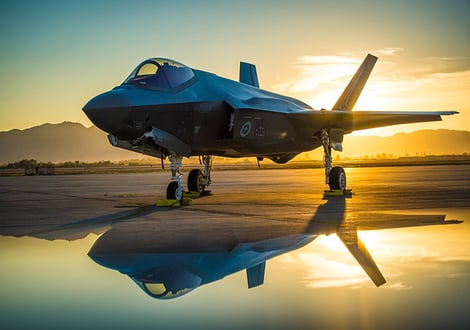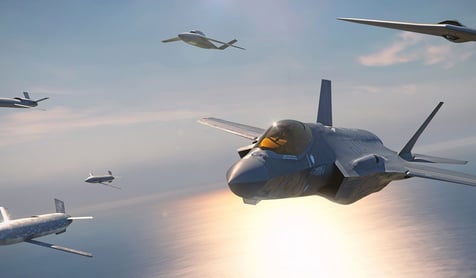Lockheed Martin, an industry leader in aerospace, defense, security, and advanced technology, is celebrated for its substantial contributions to the defense sector. With impressive revenue and a reputation for groundbreaking innovation, the company's success can be attributed to its visionary leadership.
Among these leaders is Stephen Howes, the VP, F-35 Production Operations. Howes plays a pivotal role in steering Lockheed Martin's production endeavors, particularly overseeing the domestic production of the F-35s.
His responsibilities encompass the management of critical production facilities, including the Fort Worth site, known for its component construction and the final assembly and checkout processes. Howes' leadership and insights provide a fascinating glimpse into the strategic operations and future trajectory of Lockheed Martin.
Thank you, Stephen, for meeting with us. Could you start with a brief introduction about yourself and your responsibilities at Lockheed Martin?
I'm Stephen Howes, the Vice President of Production Operations at Lockheed Martin. I oversee the domestic factory that produces F-35 jets.

We have three different final assembly and checkout facilities, inclusive of the Fort Worth facility for component build and final assembly and checkout.
The F-35 is made in four sections: forward, center, wing, and aft. The center fuselage comes from Northrop Grumman and the aft from BAE Systems. Our team assembles these components and adds advanced technology to create a fifth-generation fighter.
How did you get into the aerospace and defense industry, and have you always been interested in this line of work?
I was born and raised in Southern Louisiana with a keen interest in airplanes and aerospace. I joined the Air Force right out of high school, served at Grand Forks Air Force Base, and then pursued a mechanical engineering degree.
I joined Lockheed Martin after college, working initially on the F-22. I briefly left the aerospace industry but returned due to my strong connection to the military and the significance of the products we build at Lockheed Martin. I’ve worked on various programs, including the F-35, from its inception.
Can you describe the importance of your work at Lockheed Martin and how it influences decision-making in production?
The work we engage in at Lockheed Martin is not just about manufacturing; it’s about sustaining and protecting global security and freedom for the US and our partners. Our role is pivotal in ensuring that our customers, which include various nations and their defense forces, are always mission-ready. This readiness is a cornerstone of maintaining a stable, free world. In our decision-making process, safety, quality, cost, and schedule are not mere parameters; they are our guiding principles. Each of these elements is crucial and deeply interconnected.
Safety is paramount in every aspect of our production. The jets we manufacture, especially the F-35s, are advanced machines that require the utmost precision and care in their construction. The quality of these aircraft is non-negotiable, as they are used by pilots directly from the factory. This unique aspect of our operation – delivering jets that go straight into service without the need for two-seater versions or preliminary flights – sets a high bar for reliability and performance.
We are continually striving to balance cost-effectiveness with these stringent safety and quality requirements. Our goal is to deliver the best value to our customers without compromising the integrity and performance of our products. Efficiency is a key driver in this process, but it never overshadows the necessity for rigorous safety and quality checks.
Moreover, adhering to schedules is critical in our industry. Timely delivery of these defense assets is vital for our clients, who depend on us to support their defense and security operations. We operate in an environment where delays can have far-reaching implications, not just commercially, but geopolitically.
In sum, our work at Lockheed Martin, especially in producing the F-35s, is a complex balance of delivering uncompromised quality and safety, maintaining cost-effectiveness, and meeting stringent schedules. These jets are more than just products; they are integral to the defense strategies of nations and symbolize our commitment to supporting and protecting the world at large.
What are your thoughts on the future of industry 4.0 and 5.0?
At Lockheed Martin, we are in the midst of a substantial digital transformation, a shift that is both exciting and challenging. This transformation is not just about adopting new technologies; it's about fundamentally changing how we operate and produce. We are integrating artificial intelligence into our workflows, particularly in scheduling tasks. This integration represents a significant leap forward in how we organize and execute our production processes. The use of AI allows us to optimize our operations, ensuring that the right tasks are prioritized and completed efficiently.
Looking towards the future, we anticipate a greater role for automated systems in our production lines. These systems won’t replace human workers; rather, they will work alongside them.
This collaboration between human and machine will increase our throughput and expand our capacity, all within the existing physical footprints of our facilities. This approach is crucial in an industry where space and resources are often at a premium.
However, integrating these advanced technologies into our legacy systems presents a unique set of challenges. Our production systems have evolved over decades, and melding new, digital processes with older, established ones requires careful planning and execution. It’s not just about the technology itself, but about how we incorporate it into our existing workflows in a way that enhances rather than disrupts.
Another aspect of this transformation is the human element. We have a newer workforce that is more accustomed to a digital world. They bring with them a set of skills and expectations shaped by this background. Leveraging their digital fluency is key to our transformation. However, it also means ensuring that they are integrated effectively into our existing systems, which can be quite complex and layered with years of aerospace tradition and practice.
"In essence, our journey towards digital transformation at Lockheed Martin is about creating a synergy between the old and the new, between human expertise and machine efficiency."
It’s a delicate balance, but one that we are navigating with a clear vision of enhancing our production capabilities and maintaining our position as a leader in aerospace and defense technology.
What opportunities and challenges do you see in talent management in aerospace and defense?
In the ever-evolving landscape of aerospace and defense manufacturing, we at Lockheed Martin recognize a significant opportunity in harnessing the technological fluency of the new generation. This new generation of workers brings with them a native understanding and comfort with technology that is unparalleled. Their skills and perspectives are invaluable as we seek to enhance and modernize our production systems. They are adept at navigating digital environments, and this skill set is crucial as we integrate more advanced technological solutions into our manufacturing processes.
However, this integration is not without its challenges. A major hurdle we face is adapting our legacy systems to modern technology. These systems, which have been the backbone of our production for decades, are robust but not always flexible. Retrofitting them to work seamlessly with new, digital tools requires not only technical adjustments but also a shift in our approach to production. It's a complex task that involves a deep understanding of both the old and the new.
Another critical aspect is managing the transition of our workforce. As we introduce new technologies and processes, we must ensure that our existing employees are not left behind. This involves training and development programs that help bridge the gap between traditional manufacturing methods and the new digital-driven approaches. It's essential that we bring our long-standing employees along on this journey, blending their invaluable experience with the fresh ideas of the newer generation.
Moreover, it’s crucial to ensure that the new talent we bring in can effectively contribute to and thrive within our evolving systems. They need to understand the nuances and complexities of aerospace manufacturing, which often go beyond digital proficiency. It's about marrying their tech-savviness with the practicalities and specifics of our industry.
Lastly, what advice would you give your younger self?
Reflecting on my career journey and the lessons I've learned, I would underscore the profound importance of every role within an organization, no matter how small it may seem. Each position held is not just a job; it's an opportunity to effect change and contribute to the larger mission of the company. At Lockheed Martin, we understand that innovation and improvement are not solely the responsibilities of those at the top; they are the collective effort of every individual in the organization.
Every role, from the engineers and technicians on the production floor to the executives in the boardroom, offers a unique vantage point and the potential to drive progress. It's essential to recognize and harness the power inherent in these positions. Often, the most impactful changes and innovations come from those who are deeply involved in the day-to-day operations, as they are the ones who best understand the intricacies and challenges of the work.
This perspective is crucial for those entering the industry or taking on new roles within it. Understanding that you have the ability to influence change and improve systems from wherever you stand in the organizational hierarchy is vital. It's about taking ownership of your role, understanding its significance in the broader context of the organization's goals, and proactively seeking ways to contribute to its success. So the advice I would go back and give my younger self, is to never understand the power and the importance of the job YOU HOLD TODAY.
Moreover, recognizing the power of your current position means understanding the ripple effect of your actions. Decisions and improvements made in one area can have far-reaching impacts across the organization. This realization fosters a sense of responsibility and encourages a proactive approach to problem-solving and innovation.
"In essence, my advice, based on my experiences and observations, is to never underestimate the impact of your contributions, regardless of your position. Every job is a stepping stone to greater achievements and an integral part of the organization's journey. Embracing this mindset is key to personal growth and professional success, and it is instrumental in driving the collective progress of an organization like Lockheed Martin."
Lockheed Martin's journey, under leaders like Stephen Howes, symbolizes a blend of tradition and innovation, echoing the dynamic nature of the aerospace and defense industry. As the company navigates the challenges of modern technology and workforce evolution, its commitment to excellence and efficiency remains steadfast, propelling it into the future while safeguarding our skies.
Join Stephen Howes this Dec 4-5, 2023 at the We-Ko-Pa Resort Phoenix as he shares more insights during his plenary Future-Proofing Production Plants: How to Improve Productivity and Modernize Operations
%20(1).png?width=773&height=112&name=Generis%20Logo%20full%20Colour%20(Large)%20(1).png)




-Nov-13-2025-01-18-02-9699-PM.png)
-2.png)